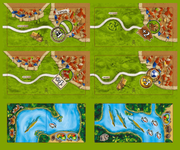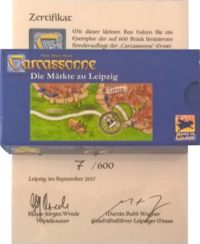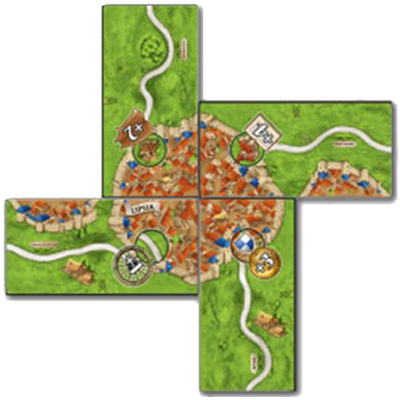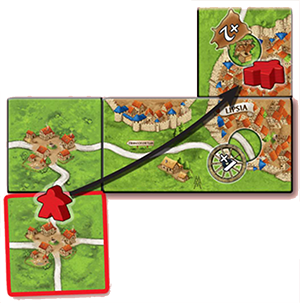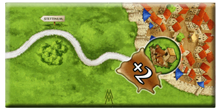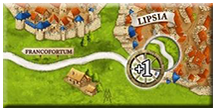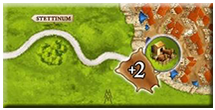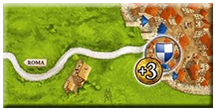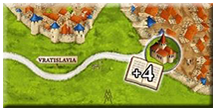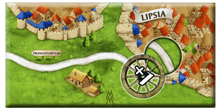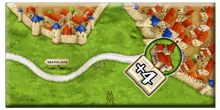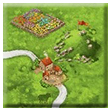The Markets of Leipzig
 |
You are reading the rules for this tile design. |
| If your tiles have a different design, then choose a game from Spin-offs. |  |

The Markets of Leipzig mini expansion contains 4 double-sized tiles that will replace the start tile. They represent different quarters of the city of Leipzig. These tiles allow you to send meeples on roads to Leipzig in order to receive bonus points according to the chosen quarter.
During the Middle Ages the town of Leipzig (lat. Lipsia) was the crossing point of the trading roads Via Regia and Via Imperii, which caused the emergence of numerous markets in this region. In the year of 1507 Leipzig became a staple town. Thus, all merchants passing through the town had to place their goods on the staple place and offer them for sale.
General info and comments
Originally released by Hans im Glück in the 2nd edition (C2 for short) in 2017 on occasion of Leipzig's fair "model-hobby-spiel" 2017, with two double tiles for Amazonas: Amazon Bonus River Tiles. A version in the 3rd edition (C3 for short) was released in 2023.
This expansion doesn't exist for the 1st edition (C1 for short), and presents some limitations if played with this edition.
This expansion was first released as a limited edition of total 600 examples: the first 300 at the "modell hobby spiel" in Leipzig from 29th September to 1st October 2017, and the second 300 at the Spiel'17 in Essen from 26th to 29th of October 2017. This limited version was signed by Klaus-Jürgen Wrede and the CEO of Leipzig's trade fair center (Messe Leipzig) and contained 13 meeples.
The Leipzig trade fair, which provides its logo as the symbol for this expansion, has its origins in the Middle Ages.
Contents
- 4 double land tiles with the city of Leipzig, to be used as an alternative start tile
- 13 additional meeples in different colors in some versions [1]
Rules
Preparation
This setup replaces the start tile. Place the land tiles in a way that the four quarters lie next to each other and form the city of Leipzig (lat. Lipsia). Rightly, the signpost for Francofortum points to the west, the one for Stettinum to the north, Vratislavia to the east and Roma to the south. For the game, however, it is not important in which order the tiles are placed. [2]
If possible, give extra meeples to each player as meeples might run low easily in this variant. The number recommended varies depending on the edition:
- C3: 2 extra meeples
- C2: 1 extra meeple
Gameplay
1. Placing a tile
The rules stay the same.
2. Placing a meeple
The rules stay the same.
3. Scoring a feature and sending a meeple to Leipzig
Each of Leipzig's quarters has one road which starts at its gate. All roads which are connected to these roads offer the possibility of sending one of your meeples to Leipzig. This counts as well for roads which are not directly connected to Leipzig, but are connected through one or more crossroads. [3] [4]
If you complete a road which leads to Leipzig, and you have the majority, you can choose to:
- Score the road and you get the points
- or
Take note:
- If you have more than one meeple on the road, you are allowed to send one of them to Leipzig. With the other(s) you may, however, score the points for the road. [8] If you send a meeple into the Wainwrights quarter you will get the bonus points (see below) immediately. [9]
- If more than one player has the majority, each one can decide on his own whether they want to send the meeple to Leipzig or if they take the points.
- Depending on the edition, the long roads on the tiles are treated differently:
You move the meeple to any one of Leipzig's quarters (it does not have to be the one where the road ends) and the meeple will remain there until the game ends. You may only have one of your meeples in each quarter of Leipzig. Meeples of more than one player are allowed in each quarter - the meeples are simply stacked.
3. Scoring the meeples of the Markets of Leipzig
When you have a meeple in a quarter of Leipzig it will score you bonus points in specific scoring phases - either during the game, or at the end. [12]
Scoring during the game
The bonus points for these three scorings count only for completed roads, cities and monasteries. In the final scoring at the end of the game you get no bonus points in these cases.
Final Scoring
Note: The city of Leipzig counts as a completed city when scoring the fields.
Other expansions
This section contains additional information about the interactions with other Carcassonne expansions.
- The movement of the dragon with double-sized tiles (
 Exp. 3 - The Princess & the Dragon)
Exp. 3 - The Princess & the Dragon) - Tower range with double-sized tiles (
 Exp. 4 - The Tower)
Exp. 4 - The Tower) - Barn placement with double-sized tiles (
 Exp. 5 - Abbey & Mayor)
Exp. 5 - Abbey & Mayor) - Trajectory and range of fliers with double-sized tiles (
 Mini #1 - The Flying Machines)
Mini #1 - The Flying Machines) - Scoring special monasteries (with a meeple placed as an abbot) with double-sized tiles (
 Monasteries in Germany,
Monasteries in Germany,  Monasteries in the Netherlands & Belgium,
Monasteries in the Netherlands & Belgium,  Japanese Buildings)
Japanese Buildings) - The plague with double-sized tiles (
 The Plague)
The Plague)
Some additional clarifications involving Leipzig tiles were also provided. [21]
![]() Question: In C2, the road on a City of Leipzig tile has to be counted as 2 points instead of 1 because road is on two "spaces"? The rules mention it is scored as one road segment... Does this still apply? Or should it be scored as two "spaces"?
Question: In C2, the road on a City of Leipzig tile has to be counted as 2 points instead of 1 because road is on two "spaces"? The rules mention it is scored as one road segment... Does this still apply? Or should it be scored as two "spaces"?
Answer: In C2, the rule does apply, therefore you still score only 1 point.
But for every other scoring in C2 and for all scorings in C3, it is considered as 2 tiles (German monasteries, dragons etc.) (1/2021; updated 11/2023)
![]() Question: So the dragon for example affects the whole tile (except the interior of the Leipzig in this case) but considers each space individually when moving.
Question: So the dragon for example affects the whole tile (except the interior of the Leipzig in this case) but considers each space individually when moving.
The same would happen to a tower range.
Answer: Exactly. (1/2021)
We will include some remarks about the implications of these clarifications next
![]() Base Game - Road and Cities
Base Game - Road and Cities
![]() However, the Leipzig tiles present a special case for roads in C2: The road segments on them occupy two spaces but they are scored as one road segment (one space) as indicated in the rules of this expansion for C2. However, in C3, the long road segments on them are scored as 2 tiles.
However, the Leipzig tiles present a special case for roads in C2: The road segments on them occupy two spaces but they are scored as one road segment (one space) as indicated in the rules of this expansion for C2. However, in C3, the long road segments on them are scored as 2 tiles.
![]() Base Game - Monasteries and abbots
Base Game - Monasteries and abbots
Note: The same considerations should be applied when removing and scoring an abbot, and the scoring of all other monastic buildings: abbeys, shrines, German monasteries / Japanese Buildings / Dutch & Belgian monasteries with monks, Darmstadt churches.
![]() Exp. 3 - The Princess & the Dragon - The fairy and Moving the dragon
Exp. 3 - The Princess & the Dragon - The fairy and Moving the dragon
![]() Exp. 4 - The Tower - Capturing meeples in Leipzig
Exp. 4 - The Tower - Capturing meeples in Leipzig
![]() Exp. 5 - Abbey & Mayor - Tanners quarter bonus during the game
Exp. 5 - Abbey & Mayor - Tanners quarter bonus during the game
![]() Mini #2 - The Messengers - Tanners quarter bonus during the game
Mini #2 - The Messengers - Tanners quarter bonus during the game
Tile distribution
Third edition C3
Second edition C2
Footnotes
For Icons explanation and licensing please visit Icons page.
- ↑
 The expansion was first released as a limited edition of total 600 examples: the 1st 300 examples at the "modell hobby spiel" in Leipzig from the 29th of September to the 1st of October 2017, and the 2nd 300 examples at the Spiel'17 in Essen from 26th to 29th of October 2017. This limited version was signed by Klaus-Jürgen Wrede and the CEO of Leipzig's trade fair center (Messe Leipzig) and contain 13 meeples. A more general version is also available which only contains the four tiles.
The expansion was first released as a limited edition of total 600 examples: the 1st 300 examples at the "modell hobby spiel" in Leipzig from the 29th of September to the 1st of October 2017, and the 2nd 300 examples at the Spiel'17 in Essen from 26th to 29th of October 2017. This limited version was signed by Klaus-Jürgen Wrede and the CEO of Leipzig's trade fair center (Messe Leipzig) and contain 13 meeples. A more general version is also available which only contains the four tiles.
- ↑
 This suggested setup places the tiles according to the geographical location of Leipzig in relation to the other cities mentioned. The tiles can be placed in any order, since the position of the quarters does not imply any restrictions for the game. The only difference will be the location of the farmhouses in two of the four fields these tiles define as the initial setup.
This suggested setup places the tiles according to the geographical location of Leipzig in relation to the other cities mentioned. The tiles can be placed in any order, since the position of the quarters does not imply any restrictions for the game. The only difference will be the location of the farmhouses in two of the four fields these tiles define as the initial setup.
- ↑
 The English C2 and C3 rules state "a village" but it should be "villages". The German rules are more precise - and now they say "one or more crossroads" (6/2021; updated 8/2024).
The English C2 and C3 rules state "a village" but it should be "villages". The German rules are more precise - and now they say "one or more crossroads" (6/2021; updated 8/2024).
- ↑
 This means this expansion only considers crossroads (with a village or trees) where 2, 3, or 4 roads end. The same features are also used in
This means this expansion only considers crossroads (with a village or trees) where 2, 3, or 4 roads end. The same features are also used in  The Tollkeepers for the placement of tollhouses.
The Tollkeepers for the placement of tollhouses.
As a result, this would rule out junctions with small cottages, such as the ones present on some tiles in Exp. 9 - Hills & Sheep.
Exp. 9 - Hills & Sheep.
The rules in C2 seemed to only consider crossroads with villages, but the wording of the rules in C3 was updated to consider all types of crossroads, leaving out cottages ending a road as in C2. Question: The base game of the Second and Third Edition of Carcassonne (C2/C3) always includes villages at every crossroads. This is not the case for the First Edition (C1), where CRRR tiles have trees at their crossroads instead of a village. Does this crossroads with trees allow you to connect a road to Leipzig as well?
Question: The base game of the Second and Third Edition of Carcassonne (C2/C3) always includes villages at every crossroads. This is not the case for the First Edition (C1), where CRRR tiles have trees at their crossroads instead of a village. Does this crossroads with trees allow you to connect a road to Leipzig as well?
 Question: So, crossroads with villages and trees are equivalent for The Markets of Leipzig. All crossroads (with a village or trees) can connect a road to Leipzig. Is this correct?
Question: So, crossroads with villages and trees are equivalent for The Markets of Leipzig. All crossroads (with a village or trees) can connect a road to Leipzig. Is this correct?
Answer: Well, this mini expansion does really work with the C1 design.
But if you would like to combine these, crossroads with trees and villages are the same. In the German rules of The Tollkeepers is also a bit more clear, because they say "a crossroads is mostly a village." This "mostly" is missing the original English translation. (8/2024)
The Tollkeepers is also a bit more clear, because they say "a crossroads is mostly a village." This "mostly" is missing the original English translation. (8/2024)
- ↑
 Sending the meeple to Leipzig becomes the scoring for the road instead of receiving points.
Sending the meeple to Leipzig becomes the scoring for the road instead of receiving points.
 Question: Red completes a road connected to Leipzig with 2 red meeples and 1 blue meeple. Red decides to send one of their meeples to Leipzig. After sending their meeple to Leipzig, the majority is reevaluated on the road and both Red and Blue (with 1 meeple each now) score for the road. Is this correct?
Question: Red completes a road connected to Leipzig with 2 red meeples and 1 blue meeple. Red decides to send one of their meeples to Leipzig. After sending their meeple to Leipzig, the majority is reevaluated on the road and both Red and Blue (with 1 meeple each now) score for the road. Is this correct?
Answer: No, it's not. Blue doesn't score, because Red has 2 meeples on the road.
Sending a meeple to Leipzig is your scoring, only if you have 2 meeple you can "double" score.
See it like this: Red has 2 meeples on the road and Blue only 1. So Blue takes their meeple back, without any scoring. Then Red "scores" by sending a meeple to Leipzig, and then Red can score again because there is still a meeple on the road. (8/2024)
This means that other bonuses and penalties associated to meeples sent to Leipzig will be granted as usual, since the meeple is scored although in a different way:- The watchtower bonus (see
 The Watchtowers)
The Watchtowers) - The fairy 3-point scoring bonus (see
 Exp. 3 - The Princess & the Dragon)
Exp. 3 - The Princess & the Dragon) - The ringmaster bonus (see
 Exp. 10 - Under the Big Top)
Exp. 10 - Under the Big Top) - The ghost penalty (see
 Exp. 11 - Ghosts, Castles & Cemeteries)
Exp. 11 - Ghosts, Castles & Cemeteries)
Moreover, other bonuses associated with the scoring of the road would be applicable even if the player does not score points for the feature. This would be the case for:
- The tollhouse bonus (see
 The Tollkeepers)
The Tollkeepers) - Bet settlements (see
 The Bets).
The Bets).
- The watchtower bonus (see
- ↑
 If more than one road connected to Leipzig is completed and scored, each one is treated separately. Players with the majority on them can send one meeple per road to Leipzig, even if it is the same player. If a player sends multiple meeples to Leipzig, each meeple has to go to a different quarter not occupied by the player previously.
If more than one road connected to Leipzig is completed and scored, each one is treated separately. Players with the majority on them can send one meeple per road to Leipzig, even if it is the same player. If a player sends multiple meeples to Leipzig, each meeple has to go to a different quarter not occupied by the player previously.
 Question: If several roads connected to Leipzig are completed with one tile placement, players with the majority on each road would be able to send one meeple from each of them to Leipzig. Is this correct?
Question: If several roads connected to Leipzig are completed with one tile placement, players with the majority on each road would be able to send one meeple from each of them to Leipzig. Is this correct?
Answer: Yes, it is.
Each scoring is separate and so you can choose what to do. (8/2024) - ↑
 No meeple on a road sending meeples to Leipzig may go to a bathhouse.
No meeple on a road sending meeples to Leipzig may go to a bathhouse.
Note: Sending a meeple to Leipzig takes precedence over sending a meeple to a bathhouse (see The Barber-Surgeons) in a 1-meeple scoring in order to avoid breaking the Leipzig mechanic.
The Barber-Surgeons) in a 1-meeple scoring in order to avoid breaking the Leipzig mechanic.
- ↑
 The majority in a road connected to Leipzig is calculated before deciding whether to send a meeple to Leipzig. Sending a meeple to Leipzig will be the scoring for the road. With more meeples on the road, you will be able to perform a "second" scoring and receive points for the road.
The majority in a road connected to Leipzig is calculated before deciding whether to send a meeple to Leipzig. Sending a meeple to Leipzig will be the scoring for the road. With more meeples on the road, you will be able to perform a "second" scoring and receive points for the road.
- ↑
 The rules explicitly mention the case involving meeples sent to the Wainwrights quarter, but this may also happen with meeples sent to the Coiners quarter or the Bookbinders quarter.
The rules explicitly mention the case involving meeples sent to the Wainwrights quarter, but this may also happen with meeples sent to the Coiners quarter or the Bookbinders quarter.
Note that meeples are sent to Leipzig during the scoring round (in Step 3B). The Leipzig bonus will be active as soon as a meeple is sent to Leipzig. So the scoring order is important, since any features scored before sending a meeple to Leipzig may not benefit from a bonus activated later in the same turn. If multiple features are completed, the order of scoring will be decided by the active player in case of conflict. Question: Any Leipzig quarter bonus (Wainwrights, Bookbinders, Coiners) can be granted in the same turn a meeple is sent to the given quarter (the reference in the rules to the Wainwrights quarter bonus is not an exception but an example). Is this correct?
Question: Any Leipzig quarter bonus (Wainwrights, Bookbinders, Coiners) can be granted in the same turn a meeple is sent to the given quarter (the reference in the rules to the Wainwrights quarter bonus is not an exception but an example). Is this correct?
Answer: Yes, this is right.
Paraphrasing the rules: "If you have more than one meeple on the road [...] you may, however, score the points for the road [...] If you send a meeple into the Wainwrights quarter you will get the bonus points (see below) immediately."
In the rules it's not clarified what you score first, so basically the person placing the tile (the active player) can choose what will be scored first (road or city or monastery). (8/2024) - ↑
 In C3, each half of the Leipzig tiles count as a square tile when scoring cities or monasteries. The exception defined in C2 for the roads is now discarded, to align the rules with other C3 mini expansions including non-square tiles.
In C3, each half of the Leipzig tiles count as a square tile when scoring cities or monasteries. The exception defined in C2 for the roads is now discarded, to align the rules with other C3 mini expansions including non-square tiles.
- ↑
 In C2, the long road along the tile counts as 1 tile when scoring the road, although the tile counts as 2 square tiles when scoring monasteries.
In C2, the long road along the tile counts as 1 tile when scoring the road, although the tile counts as 2 square tiles when scoring monasteries.
- ↑
 In general terms, the rules indicate that The Markets of Leipzig provides bonus points for all the features affected, so they are not part of the core feature scoring in any case.
In general terms, the rules indicate that The Markets of Leipzig provides bonus points for all the features affected, so they are not part of the core feature scoring in any case.
- ↑
 The additional point per tile would be applied as a bonus after all other modifiers to the core feature scoring. That is, it is applied after Inns (see
The additional point per tile would be applied as a bonus after all other modifiers to the core feature scoring. That is, it is applied after Inns (see  Exp. 1 - Inns & Cathedrals), German Cathedrals (see
Exp. 1 - Inns & Cathedrals), German Cathedrals (see  German Cathedrals) and Mage and Witch scoring modifiers (see
German Cathedrals) and Mage and Witch scoring modifiers (see  Mini #5 - Mage & Witch.)
Mini #5 - Mage & Witch.)
So it will be applied along with other bonus points affecting the road such as Little Buildings (see Little Buildings.)
Little Buildings.)
- ↑
 By extension, this bonus would affect not only monasteries but all other monastic buildings scored during the game. Monastic buildings are: monasteries, abbeys (see
By extension, this bonus would affect not only monasteries but all other monastic buildings scored during the game. Monastic buildings are: monasteries, abbeys (see  Exp. 5 - Abbey & Mayor), shrines (see
Exp. 5 - Abbey & Mayor), shrines (see  Exp. 6 - Count, King & Robber), German monasteries (see
Exp. 6 - Count, King & Robber), German monasteries (see  Monasteries in Germany), Dutch & Belgian monasteries (see
Monasteries in Germany), Dutch & Belgian monasteries (see  Monasteries in the Netherlands & Belgium), Japanese buildings (see
Monasteries in the Netherlands & Belgium), Japanese buildings (see  Japanese Buildings), Darmstadt churches (see
Japanese Buildings), Darmstadt churches (see  Darmstadt Promo). German Cathedrals (see
Darmstadt Promo). German Cathedrals (see  German Cathedrals) and gardens (see
German Cathedrals) and gardens (see  The Abbot) are not considered.
The Abbot) are not considered.
- ↑
 Completed, unoccupied monasteries will not trigger the Bookbinders quarter bonus.
Completed, unoccupied monasteries will not trigger the Bookbinders quarter bonus.
 Question: The Bookbinders quarter bonus is not scored for an unoccupied monastery. The bonus is only scored for completed, occupied monasteries (no matter the player). Is this correct?
Question: The Bookbinders quarter bonus is not scored for an unoccupied monastery. The bonus is only scored for completed, occupied monasteries (no matter the player). Is this correct?
Answer: Yes. If there is no player in the monastery, you didn't score it and no Bookbinders quarter bonus is received. (8/2024)
- ↑
 Completed, unoccupied monasteries in the fief of a castle will not trigger the Bookbinders quarter bonus even if the castle scores points for the completed monastery.
Completed, unoccupied monasteries in the fief of a castle will not trigger the Bookbinders quarter bonus even if the castle scores points for the completed monastery.
 Question: A completed, unoccupied monastery will not grant the Bookbinders quarter bonus even if a castle (see
Question: A completed, unoccupied monastery will not grant the Bookbinders quarter bonus even if a castle (see  Exp. 8 - Bridges, Castles & Bazaars ) scores points for the unoccupied monastery. Only a monastery scoring points directly is taken into consideration (completed and occupied). Is this correct?
Exp. 8 - Bridges, Castles & Bazaars ) scores points for the unoccupied monastery. Only a monastery scoring points directly is taken into consideration (completed and occupied). Is this correct?
Answer: Yes. In the rules of Exp. 8 for the castle, it is also written "complete" not "scored". (8/2024)
- ↑
 Players do not get the bonus points when an abbot is removed/scored before the monastery is completed. These bonus points can only be received when an occupied monastic building is scored by a player after completion. A castle scoring points for an unoccupied monastic building will not trigger this bonus either.
Players do not get the bonus points when an abbot is removed/scored before the monastery is completed. These bonus points can only be received when an occupied monastic building is scored by a player after completion. A castle scoring points for an unoccupied monastic building will not trigger this bonus either.
- ↑
 This scoring bonus for fields is especially designed for C2. There is no official clarification about how fields are scored for tiles with C1 artwork.
This scoring bonus for fields is especially designed for C2. There is no official clarification about how fields are scored for tiles with C1 artwork.
- ↑
 C1 fields may be scored taking into consideration the little farmhouses present on them.
C1 fields may be scored taking into consideration the little farmhouses present on them.
- ↑
 The wording indicates that this bonus only applies to field scoring. Therefore barns do not get this bonus when scored, no matter their owners have a meeple in the Tanners quarter.
The wording indicates that this bonus only applies to field scoring. Therefore barns do not get this bonus when scored, no matter their owners have a meeple in the Tanners quarter.
- ↑
 These clarifications can be found on Carcassonne Central here:
These clarifications can be found on Carcassonne Central here:
http://www.carcassonnecentral.com/community/index.php?topic=5021.msg74245#msg74245
- ↑ Jump up to: 22.0 22.1
 The rules are clear about the Tanners quarter when playing with the basic game, where fields are only evaluated at the end of the game. This limitation applies to those expansions that may score fields during the game, such as
The rules are clear about the Tanners quarter when playing with the basic game, where fields are only evaluated at the end of the game. This limitation applies to those expansions that may score fields during the game, such as  Exp. 5 - Abbey & Mayor and
Exp. 5 - Abbey & Mayor and  Mini #2 - The Messengers.
Mini #2 - The Messengers.
 Question: The rules of The Markets of Leipzig say: "Tanners quarter: For each field scoring at the end of the game..."
Question: The rules of The Markets of Leipzig say: "Tanners quarter: For each field scoring at the end of the game..."
a) Is the mention of "at the end of the game" just a comment to stress that fields are normally scored at the end of the game? The farmer rules say "...farmers are not scored during the game..." but we know this is not written in stone with some expansions.
b) Is the mention of "at the end of the game" an explicit limitation so any fields scored during the game (e.g. due to barns) cannot receive the Tanners quarter bonus?Answer: There rules say "at the end of the game", so you have to do this at the end of the game.
This limitation may make the Tanners quarter bonus weaker than the other bonuses, but all expansions are balanced with the base game.
It's the same with the The Wonders of Humanity, we try to give each more or less the same power with about 100 tiles. But when you play with 400 tiles the effects are completely different and stronger. (8/2024)
The Wonders of Humanity, we try to give each more or less the same power with about 100 tiles. But when you play with 400 tiles the effects are completely different and stronger. (8/2024)
The rules of The Markets of Leipzig and
 The Wonders of Humanity consider "at the end of the game" as a hard limitation, so fields scored during the game don't get the Tanners quarter bonus nor the Wonder bonuses applicable at the end of the game. This could seem a very hard limitation when you play large games (a Mega-Carcassonne), but HiG can't do rules for every possibility.
The Wonders of Humanity consider "at the end of the game" as a hard limitation, so fields scored during the game don't get the Tanners quarter bonus nor the Wonder bonuses applicable at the end of the game. This could seem a very hard limitation when you play large games (a Mega-Carcassonne), but HiG can't do rules for every possibility.
Note that the release of
 The Wonders of Humanity was delayed due to some unbalanced scoring issues, so these limitations try to keep the game fair in scenarios that couldn't be analyzed during the creation of these expansions.
The Wonders of Humanity was delayed due to some unbalanced scoring issues, so these limitations try to keep the game fair in scenarios that couldn't be analyzed during the creation of these expansions.
- ↑ Jump up to: 23.0 23.1
 The Tanners quarter bonus also affects the early evaluation of fields in expansions such as
The Tanners quarter bonus also affects the early evaluation of fields in expansions such as  Exp. 5 - Abbey & Mayor and
Exp. 5 - Abbey & Mayor and  Mini #2 - The Messengers.
Mini #2 - The Messengers.

